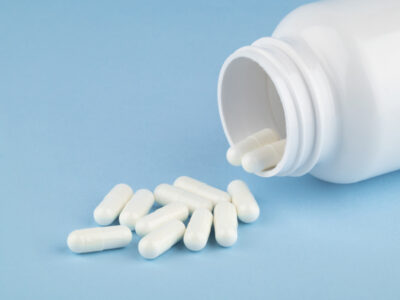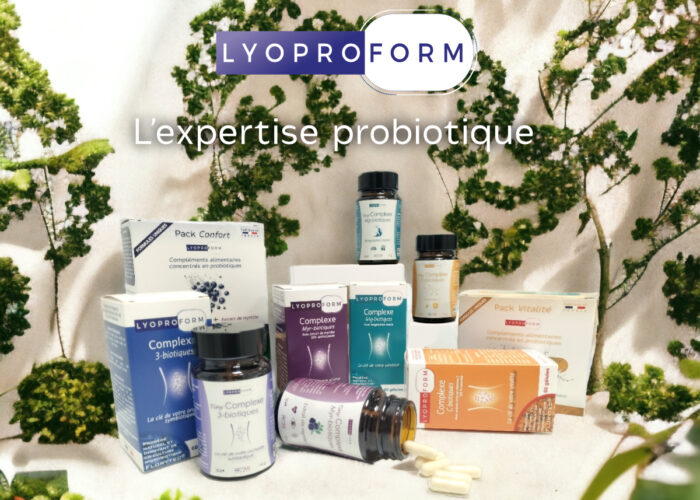The probiotics of our intestinal flora, these living micro-organisms that contribute to our digestive comfort, are becoming increasingly popular.
However, to make the most of these beneficial bacteria, it’s essential to know how to consume a probiotic optimally and effectively.
1. Take probiotics just before a meal
When taking probiotics, it’s important to combine them with your meal. Why is this ? Because the food bolus contains essential nutrients that promote the growth and survival of probiotics. Studies have shown that these microorganisms survive gastric transit better in the presence of glucose or protein¹,².
These micro-organisms need these nutrients to withstand the acidic conditions of the stomach and thus thrive within our intestinal flora.
Gastro-resistant capsules have also proved effective in preventing probiotics from being degraded in the stomach and duodenum. These capsules are protected by a special coating. It is most often gellan gum, which prevents the capsule from disintegrating in the stomach and protects its contents.
This non-toxic additive3 is commonly used in both conventional and organic foods.
Probiotics protected by this type of capsule are therefore to be preferred.

2. Rigorous & regular intake over a sufficient period of time
Probiotics are not a miracle solution with an immediate effect. Their positive impact on digestive comfort is generally felt over the long term. It is therefore essential to take probiotics regularly and over a prolonged period to achieve optimum results. A regular daily intake ensures the proper development of these micro-organisms within the intestinal flora and reduces the need for a long-term course of treatment. However, continued use can help maintain a healthy balance of intestinal flora, boosting the immune system and improving the action of your microbiota on digestion.

3. Avoid overdosing
When it comes to probiotics, a high concentration is not necessarily better. An overdose of probiotics can lead to undesirable effects such as bloating, gas and other gastrointestinal disorders. It is recommended to follow the manufacturer’s instructions and the advice of a healthcare professional to determine the effective dose. For most probiotics, a moderate amount is enough to obtain benefits without overloading your digestive system.
4. Combine with a healthy diet rich in prebiotic fibre
To optimize the effects of probiotics, it is important to combine them with a balanced diet rich in prebiotic fibers. Prebiotic fibres are non-digestible food components that serve as food for probiotics and encourage their growth. There are many foods rich in prebiotic fibers: onions, garlic, leeks, bananas, chicory, asparagus, wheat and certain other cereals are among the foods that contain prebiotics such as fructo-oligosaccharides (fos) and inulin. By incorporating these foods into your diet, you create the right environment for probiotics to thrive.

5. Combine with ingredients recognized for their beneficial properties
To maximize the benefits of probiotics, it’s a good idea to combine them with other ingredients known for their beneficial health properties. For example, vitamin C helps strengthen our immune system, vitamin D plays a crucial role in calcium absorption, and magnesium is essential for numerous biochemical reactions in the body, including fatigue reduction. By including these nutrients in your diet, you can reinforce the beneficial action of probiotics and contribute to optimal overall health. In conclusion, taking probiotics is beneficial for digestive health and general well-being.. However, it is essential to take them correctly if you are to reap all their benefits. By combining them with varied, balanced meals, using them regularly over the long term, avoiding overdosing, following a healthy diet rich in prebiotic fiber, and combining them with other beneficial nutrients, you can optimize the effectiveness of probiotics in your wellness routine. Don’t forget to consult a healthcare professional or nutritionist for personalised advice on taking probiotics to meet your specific needs.
1- Développement et application d’une méthodologie in vitro pour déterminer la tolérance au transit d’espèces potentiellement probiotiques de Lactobacillus et Bifidobacterium dans le tractus gastro-intestinal supérieur de l’homme, W P Charteris 1, P M Kelly, L Morelli, J K Collins, J Appl Microbiol. 1998 May;84(5):759-68. doi: 10.1046/j.1365-2672.1998.00407.x.
2- Survival of Probiotic Lactobacilli in Acidic Environments Is Enhanced in the Presence of Metabolizable Sugars, B. M. Corcoran,1,2 C. Stanton,1,3 G. F. Fitzgerald,2,3 and R. P. Ross, Appl Environ Microbiol. 2005 Jun; 71(6): 3060–3067.doi: 10.1128/AEM.71.6.3060-3067.2005
3- EFSA Panel on Food Additives and Nutrient Sources added to Food (ANS), , , , , , , , , , , , , , , , , , , , , , , , , , and , 2018. Scientific Opinion on the re-evaluation of gellan gum (E 418) as food additive. EFSA Journal 2018;16(6):5296, 39 pp. doi: 10.2903/j.efsa.2018.5296









